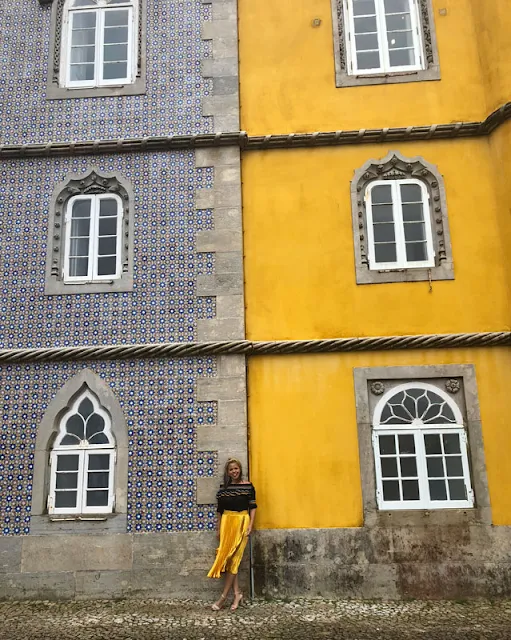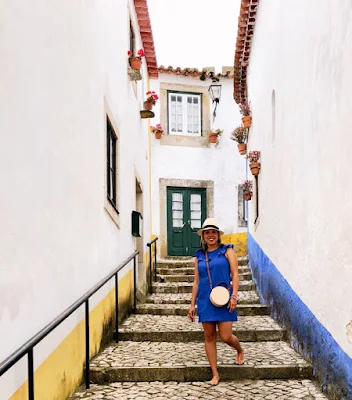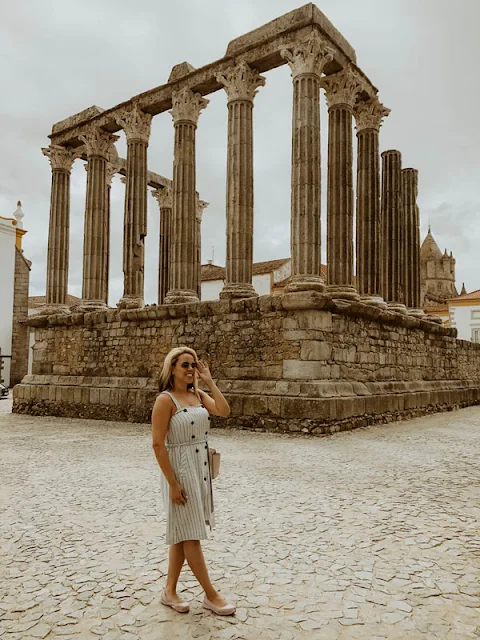Portugal has some of the most beautiful towns as it has hundreds of years of history with influences from the Moors. Expect to see cobblestone streets in every town, tons of castles and forts across the country, colorful tiles on building facades and scenic coastlines and rock formations. The people are very friendly and many people speak English. The cuisine is seafood based, but I enjoyed the wonderful pastries and Portuguese wine. The wine there was very cheap, $2 for a bottle in a grocery store and $2 for a glass in restaurants. Portugal is famous for its Port wine but also has several other varieties such as Vinho Verde which you can find here in Trader Joe’s.
The weather stays relatively warm year round. I was able to easily use public transportation in the big cities and also traveled by train long distance (which you can do for far less than what you pay anywhere else in Europe). I drove through most of the country; and seeing the countryside really gives you a different view of the country. In between the large cities are vineyards, cork farms, olive tree groves and in between the trees are fields of purple wildflowers. Portugal is the world’s leading producer of cork and its not just used as wine stoppers. They are made into bags, hats, shoes and other items. Cork is a great material for shoes because it’s like an orthopedic molding to the shape of your foot, is flexible, and odor-resistant. Cork can float, is elastic and resistant to both water and fire. Cork trees re-grow its bark every 9 years. You know Birkenstocks use cork in their footbeds.
 |
| Olive tree grove with purple wildflowers (taken from a moving vehicle) |

I found Portugal very safe, even when I was walking around by myself. The people I met were all friendly. I didn't have any unpleasant encounters. Portugal is extremely affordable, in comparison to other European countries. I'd definitely say Portugal is underrated as whenever I hear people talk about their favorite European city they never mention one from Portugal. It's surprising to me because Portugal is so beautiful and full of rich history.
1. Sintra
No visit to Portugal is complete without seeing the fairy tale castle Pena Palace on the outskirts of Lisbon! This UNESCO World Heritage site was built in the 19th century originally as a monastery but then later as a summer palace for royalty. The rooms inside still have their original furnishing and the prettiest kitchen. The outside walls are painted yellow and red as well as blue azulejo tiles. Sintra can easily be reached by a cheap 45 min train ride from Lisbon. There are a few other palaces there that I did not get to see that are equally as beautiful. Make sure you wear comfortable shoes because there’s a lot of walking, I learned this the hard way.
2. Cascais
Also outside of Lisbon is the town considered the Portuguese riveria with its beautiful beaches. The palm tree filled town has lots of shops and restaurants. So many were selling sea shells and dream catchers. It’s best explored by foot. The buildings are painted colorful colors. Cascais can be reached from Lisbon by taxi, train, bus or speedboat. The beach is a popular spot for surfers due to the wind. A short drive away in Parque Natural de Sintra-Cascais is the Cabo da Roca lighthouse on a cliff with its own micro climate. It feels like you’re on the edge of the world, it’s a spectacular sight to see. It’s the westernmost point of Europe at the ocean overlook.
3. Obidos
Obidos is a charming fortified village with narrow cobblestone streets filled with small houses painted white with a blue or yellow stripe, and a medieval castle. It’s a small town that you can easily wonder around on your own. The city walls were built to protect against the harbor that has now dried up. You enter Obidos through the town gate built in 1380. Inside the gate are azulejo tiles that make up a small chapel. The fort was built by the Moors in the 9th century. First thing I did was walk along the main street to see all the souvenir shops. I enjoyed a glass of Ginja, a sweet cherry brandy liquor served in an edible chocolate cup. The side streets are full of beautiful bougainvillea flowers. On the way to the entrance to the fort you’ll pass two beautiful churches. I didn’t climb the many steep stairs to walk the fort because I heard a tourist recently fell to his death by doing so. It’s a one hour drive out of Lisbon.
Considered the Venice of Portugal with its Canals, but on a much smaller scale. The canal run through the heart of Aveiro’s center and the beautifully painted boats take you through the lagoons. The sidewalks have a pretty black and white motifs on them in geometric patterns which you will find throughout Portugal. It was raining when I was here and I was only here for an hour so I didn’t get to see much of it. Next time I would love to go see the nearby beach of Costa Nova.

is a UNESCO World Heritage city, here you will find a Roman Temple from the 1st century, a Cathedral, and a bone chapel. The Franciscan monks collected 5000 bones from the town graves and used them to build a chapel. “We bones that are here are waiting for yours,” warns the inscription carved into the stone above the entrance. The bones are arranged in an artistic pattern of rows of arm bones and skulls. The Cathedral, built in the 14th century, has cloisters you can visit with a spiral staircase to the roof for a view of the city. For an even higher view you can go up 135 steps to the roof which I skipped. I went to a nearby winery for some wine tasting.
6. Marvao
The New York Times included this town in its list of 1000 places to see before you die. The charming town is set on top of a hill surrounded by a fortification wall. Walking through the town you’ll see lots of white houses and churches. The castle, built in the 13th century, sits at the top of the town with a labyrinth garden in front of it. It has a cistern that could hold water for 6 months in case of an attack. This medieval town wasn’t crowded at all, definitely off the beaten track.






























No comments